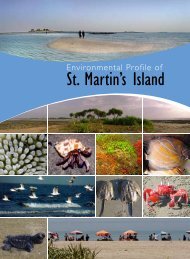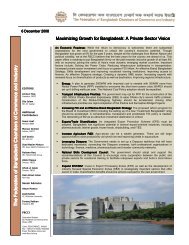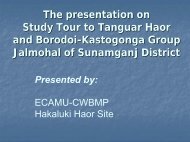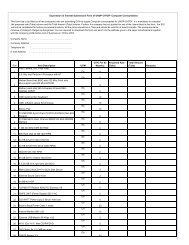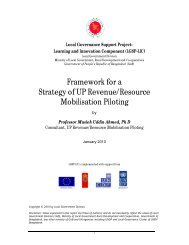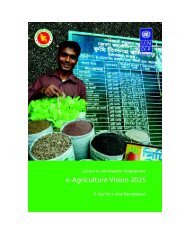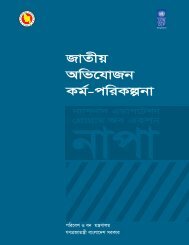The probable impacts of climate change on poverty - UNDP
The probable impacts of climate change on poverty - UNDP
The probable impacts of climate change on poverty - UNDP
You also want an ePaper? Increase the reach of your titles
YUMPU automatically turns print PDFs into web optimized ePapers that Google loves.
found that boro rice would enjoy good harvest under severe <str<strong>on</strong>g>climate</str<strong>on</strong>g> <str<strong>on</strong>g>change</str<strong>on</strong>g> scenario with doubling <str<strong>on</strong>g>of</str<strong>on</strong>g><br />
atmospheric c<strong>on</strong>centrati<strong>on</strong> <str<strong>on</strong>g>of</str<strong>on</strong>g> CO (Karim et al., 1999).<br />
2<br />
<str<strong>on</strong>g>The</str<strong>on</strong>g> apparent increase in yield <str<strong>on</strong>g>of</str<strong>on</strong>g> boro (dry seas<strong>on</strong> rice crop generally grown under irrigated c<strong>on</strong>diti<strong>on</strong>s and<br />
includes high yielding varieties) and other crops might be c<strong>on</strong>strained by moisture stress. A 60 % moisture stress<br />
<strong>on</strong> top <str<strong>on</strong>g>of</str<strong>on</strong>g> other effects might cause as high as 32 % decline in boro yield, instead <str<strong>on</strong>g>of</str<strong>on</strong>g> having an overall 20 % net<br />
increase. It is feared that moisture stress would be more intense during the dry seas<strong>on</strong>, which might force the<br />
Bangladeshi farmers to reduce the area for boro cultivati<strong>on</strong>. Shortfall in foodgrain producti<strong>on</strong> would severely<br />
threaten food security <str<strong>on</strong>g>of</str<strong>on</strong>g> the <strong>poverty</strong>-ridden country.<br />
Under a severe (4oC temperature rise) <str<strong>on</strong>g>climate</str<strong>on</strong>g> <str<strong>on</strong>g>change</str<strong>on</strong>g> scenario the potential shortfall in rice producti<strong>on</strong> could<br />
exceed 30 % from the trend, while that for wheat and potato could be as high as 50 % and 70 % respectively<br />
(Karim, 1996). Under a moderate <str<strong>on</strong>g>climate</str<strong>on</strong>g> <str<strong>on</strong>g>change</str<strong>on</strong>g> scenario the crop loss due to salinity intrusi<strong>on</strong> could be about<br />
0.2 Mt (Habibullah et al., 1998). <str<strong>on</strong>g>The</str<strong>on</strong>g> loss <str<strong>on</strong>g>of</str<strong>on</strong>g> producti<strong>on</strong> due to such effects may be relatively higher compared to<br />
that under floods. However, the loss incurred in other sectors could be much higher in case <str<strong>on</strong>g>of</str<strong>on</strong>g> floods than the<br />
direct climatic <str<strong>on</strong>g>change</str<strong>on</strong>g>s. <str<strong>on</strong>g>The</str<strong>on</strong>g> effect <str<strong>on</strong>g>of</str<strong>on</strong>g> low-flow <strong>on</strong> agricultural vulnerability is c<strong>on</strong>sidered to be much less intense<br />
compared to other effects. <str<strong>on</strong>g>The</str<strong>on</strong>g> ultimate <str<strong>on</strong>g>impacts</str<strong>on</strong>g> <str<strong>on</strong>g>of</str<strong>on</strong>g> loss <str<strong>on</strong>g>of</str<strong>on</strong>g> food grain producti<strong>on</strong> would increase import <str<strong>on</strong>g>of</str<strong>on</strong>g> food<br />
which will require spending hard currency.<br />
6.3 Fisheries<br />
<str<strong>on</strong>g>The</str<strong>on</strong>g>re is limited quantitative assessment <str<strong>on</strong>g>of</str<strong>on</strong>g> <str<strong>on</strong>g>impacts</str<strong>on</strong>g> <str<strong>on</strong>g>of</str<strong>on</strong>g> <str<strong>on</strong>g>climate</str<strong>on</strong>g> <str<strong>on</strong>g>change</str<strong>on</strong>g> <strong>on</strong> fisheries but it is anticipated that<br />
aquaculture will be affected adversely due to increased flooding and lack <str<strong>on</strong>g>of</str<strong>on</strong>g> availability <str<strong>on</strong>g>of</str<strong>on</strong>g> water in the dry seas<strong>on</strong>.<br />
While producti<strong>on</strong> may increase in open water fisheries as a result <str<strong>on</strong>g>of</str<strong>on</strong>g> m<strong>on</strong>so<strong>on</strong> flood. <str<strong>on</strong>g>The</str<strong>on</strong>g>refore, total producti<strong>on</strong> <str<strong>on</strong>g>of</str<strong>on</strong>g><br />
freshwater fishes may remain same. It is also expected that compositi<strong>on</strong> <str<strong>on</strong>g>of</str<strong>on</strong>g> coastal fisheries may <str<strong>on</strong>g>change</str<strong>on</strong>g> overtime<br />
as a result <str<strong>on</strong>g>of</str<strong>on</strong>g> coastal inundati<strong>on</strong> and salinity intrusi<strong>on</strong>. It is also anticipated that livestock will face fodder crisis in<br />
the coastal and heat related stress in the north-west regi<strong>on</strong> <str<strong>on</strong>g>of</str<strong>on</strong>g> the country.<br />
6.3.1 Existing Impacts – Percepti<strong>on</strong><br />
Climate <str<strong>on</strong>g>change</str<strong>on</strong>g> will have both negative and positive <str<strong>on</strong>g>impacts</str<strong>on</strong>g> <strong>on</strong> fisheries. <str<strong>on</strong>g>The</str<strong>on</strong>g> positive impact is possible increase<br />
in the open water fisheries during flood. It appears that the <str<strong>on</strong>g>impacts</str<strong>on</strong>g> would not be remarkable in nati<strong>on</strong>al c<strong>on</strong>text<br />
rather it would affect investment at individual level. <str<strong>on</strong>g>The</str<strong>on</strong>g> key experts’ interviews and c<strong>on</strong>sultati<strong>on</strong> workshops<br />
revealed that flood and cycl<strong>on</strong>e affect culture fisheries severely while affect <str<strong>on</strong>g>of</str<strong>on</strong>g> other shocks such as drought,<br />
salinity intrusi<strong>on</strong>, erratic rainfall, heat wave, cold wave, fogginess is low to moderate. Flood causes fish loss<br />
damaging p<strong>on</strong>d dykes, hatcheries, nurseries and embankments. It also affects fish producti<strong>on</strong> through disease<br />
outbreaks and p<strong>on</strong>d siltati<strong>on</strong>. Fish producti<strong>on</strong> may also be hampered by affecting breeding ground <str<strong>on</strong>g>of</str<strong>on</strong>g> fish due to<br />
siltati<strong>on</strong> <str<strong>on</strong>g>of</str<strong>on</strong>g> fish habitat. <str<strong>on</strong>g>The</str<strong>on</strong>g>se affect livelihoods <str<strong>on</strong>g>of</str<strong>on</strong>g> fishermen and fish farmers.<br />
Coastal aquaculture and fisheries are severely affected by cycl<strong>on</strong>e and storm surges. Cycl<strong>on</strong>e causes destructi<strong>on</strong> <str<strong>on</strong>g>of</str<strong>on</strong>g><br />
fishers’ lives and properties (boats, nets etc.). It damages fish landing and marketing centres, aquaculture<br />
infrastructure including embankments, sluice gate, hatcheries, and nurseries. In the drought pr<strong>on</strong>e areas, fish<br />
producti<strong>on</strong> decreases due to drying up <str<strong>on</strong>g>of</str<strong>on</strong>g> inland water bodies or limited availability <str<strong>on</strong>g>of</str<strong>on</strong>g> water. It also affects fish<br />
stock, growth and breeding <str<strong>on</strong>g>of</str<strong>on</strong>g> fishes. Moreover, drought causes disease outbreaks, reducti<strong>on</strong> <str<strong>on</strong>g>of</str<strong>on</strong>g> fisheries seas<strong>on</strong>s<br />
and declinati<strong>on</strong> <str<strong>on</strong>g>of</str<strong>on</strong>g> broods <str<strong>on</strong>g>of</str<strong>on</strong>g> natural SIS.<br />
Salinity intrusi<strong>on</strong> affects freshwater fisheries by decreasing inland water bodies. It decreases income and nutriti<strong>on</strong><br />
<str<strong>on</strong>g>of</str<strong>on</strong>g> rural poor but has positive <str<strong>on</strong>g>impacts</str<strong>on</strong>g> <strong>on</strong> coastal shrimp culture. Erratic rainfall adversely affect natural spawning<br />
<str<strong>on</strong>g>of</str<strong>on</strong>g> fish including major carp spawning in Halda river and Kaptai lake and ultimately fish producti<strong>on</strong> and fishers.<br />
Cold wave and fogginess also adversely affect fisheries. Cold wave affects breeding performance and growth <str<strong>on</strong>g>of</str<strong>on</strong>g><br />
fish species which reduces fish producti<strong>on</strong>. Besides, fogginess causes fish mortality in aquaculture p<strong>on</strong>d and small<br />
water bodies due to depleti<strong>on</strong> <str<strong>on</strong>g>of</str<strong>on</strong>g> dissolve oxygen.<br />
6.3.2 Future Impacts<br />
It is likely that fisheries sector will face the similar problem related to <str<strong>on</strong>g>climate</str<strong>on</strong>g> <str<strong>on</strong>g>change</str<strong>on</strong>g> including variability and<br />
48<br />
<str<strong>on</strong>g>The</str<strong>on</strong>g> Probable Impacts <str<strong>on</strong>g>of</str<strong>on</strong>g> Climate Change <strong>on</strong> Poverty and Ec<strong>on</strong>omic Growth and<br />
the Opti<strong>on</strong>s <str<strong>on</strong>g>of</str<strong>on</strong>g> Coping with adverse Effect <str<strong>on</strong>g>of</str<strong>on</strong>g> Climate Change in Bangladesh



